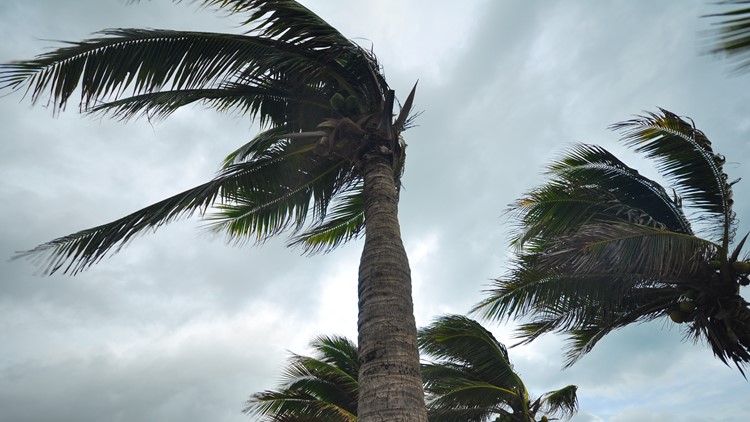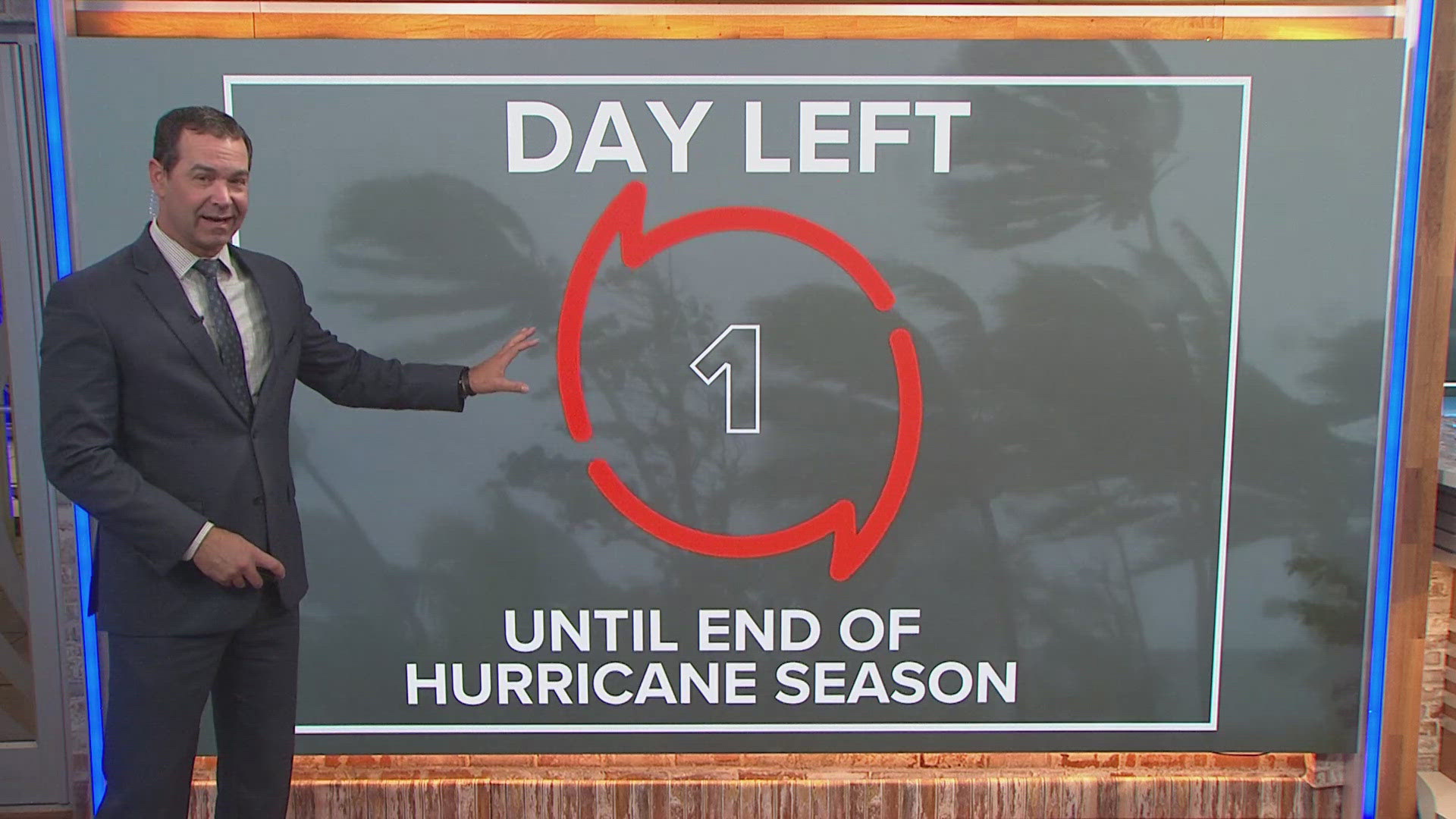ST. PETERSBURG, Fla. — When will hurricane season end?
It's a question on seemingly everyone's mind as many in the Tampa Bay area continue to recover from Hurricanes Helene and Milton. The region was on alert as meteorologists began tracking Tropical Storm Sara, but the storm has since dissipated.
Hurricane season does not end until Nov. 30. We can still see a hurricane make landfall in Florida in November, although it is rare.
The latest hurricane to make landfall along Florida's Gulf Coast was Hurricane Kate on Nov. 21, 1985. Sustained winds were near 100 mph in Panama City at landfall.
Two other hurricanes that made November landfalls in Florida include Hurricane Yankee in 1935 and Hurricane Nicole in 2022.
Fast forward to present day, and with Tropical Storm Sara in the rear-view mirror, there is no expected development in the next 5 days.
Here are key dates for the 2024 Atlantic hurricane season:
May 23
The National Oceanic and Atmospheric Administration releases its highest pre-hurricane-season outlook in its history. Its forecast then called for 17 to 25 named storms, 8 to 13 hurricanes and 4 to 7 major hurricanes (Category 3 or higher).
June 1
The 2024 Atlantic hurricane season officially begins.
June 19
Tropical Storm Alberto forms at 10 a.m. and continues to gradually strengthen.
June 20
Tropical Storm Alberto makes landfall around Tampico, Mexico with maximum sustained winds of 50 mph. It quickly dissipates after landfall. Portions of southeast Texas and Southwest Louisiana felt mild impacts.
June 28
Tropical Storm Beryl forms. The storm began as a "long-lived" tropical cyclone that developed in what the NOAA calls the "deep tropical Atlantic's Main Development Region."
June 29
After rapidly strengthening, Hurricane Beryl forms, becoming the first hurricane of the 2024 Atlantic hurricane season.
June 30
Tropical Storm Chris forms, bringing heavy rainfall and flooding to portions of eastern Mexico.
July 1
Hurricane Beryl continues to get stronger, making landfall as a high-end Category 4 storm on the island of Carriacou in Grenada. After landfall, it would continue on, becoming a Category 5 storm in the Eastern Caribbean Sea.
By 10 a.m., Tropical Storm Chris dissipates over Mexico's rugged terrain while still bringing heavy rainfall.
July 5
After Hurricane Beryl began to weaken, it made a second landfall on the Yucatan Peninsula as a high-end Category 2 hurricane. Later that evening, it downgrades to a tropical storm.
July 8
Beryl regains hurricane strength and makes a third landfall near Mategorda, Texas.
July 9
Beryl downgrades to a post-tropical cyclone.
July 26
NOAA begins monitoring a tropical wave. This would ultimately become the first hurricane to make landfall in Florida in 2024.
Aug. 3
Tropical Storm Debby forms in the southeastern Gulf of Mexico before rapidly strengthening into a Category 1 hurricane.
Aug. 4
Hurricane Debby makes landfall as a Category 1 storm near Steinhatchee, Florida, in the state's Big Bend region.
Aug. 6
Hurricane Debby moves inland over northern Florida and southern Georgia before making its way back into the ocean off the coast of South Carolina.
Aug. 8
Now a tropical storm, Debby makes a second landfall near Bulls Bay, South Carolina.
Aug. 10
As Debby passes Charlotte, North Carolina, it downgrades into a tropical depression before becoming a post-tropical cyclone heading toward Canada.
Aug. 12
Tropical Storm Ernesto forms in the Atlantic, tracking toward the Leeward Islands.
Aug. 14
Ernesto reaches hurricane strength as it passes Puerto Rico.
Aug. 17
Hurricane Ernesto makes landfall in Bermuda as a Category 1 storm.
Aug. 20
Ernesto downgrades to a "powerful post-tropical cyclone" over the North Atlantic.
Aug. 27
After an aggressive start with Hurricane Beryl reaching Cat 5 status, forecasters begin to question why the tropics have entered a quiet lull.
Sept. 7
The tropics come alive, with forecasters beginning to track Tropical Wave Invest 97-L in the Southwestern Gulf of Mexico.
Sept. 8
Forecasters designate the system as Potential Tropical Cyclone Six and start predicting a hurricane.
Sept. 9
Tropical Storm Francine forms as it moves northward toward Louisiana.
Sept. 10
The statistical peak of hurricane season. Tropical Storm Francine reaches hurricane strength, fueled by the Gulf's "exceptionally warm waters."
Sept. 11
Hurricane Francine strengthens further to a Category 2 storm. It makes landfall around 5 p.m. in southern Louisiana. After moving inland, Francine downgrades to a tropical storm.
Sept. 12
Francine downgrades to a depression before eventually dissipating.
Sept. 13
Tropical Storm Gordon forms without ever threatening land.
Sept. 18
With forecasters monitoring three areas of development in the tropics, one area in particular stands out in the Caribbean Sea. This would eventually become Helene.
Sept. 22
Future Hurricane Helene gets the designation of Potential Tropical Cyclone Nine.
Sept. 24
Tropical Storm Helene forms over the Northwestern Caribbean Sea. Hurricane and storm surge watches are in effect for portions of the Florida Gulf Coast. Governor DeSantis issues a state of emergency.
Sept. 25
Tropical Storm Helene strengthens into a hurricane as forecasters predict life-threatening storm surge, damaging winds and flooding rains for Florida and the Southeastern United States.
Tropical Storm Isaac forms in the open Atlantic.
Sept. 26
As Hurricane Helene tracks toward Florida's Big Bend region, the Tampa Bay region starts to feel impacts as storm surge and flooding begins. Hurricane Helene made landfall near Perry, Florida at 11:25 p.m. as a powerful Category 4 storm.
Sept. 27
Helene brings hurricane-force winds into the southeastern United States and tropical-storm-force winds to Tennessee and Ohio Valleys. Kentucky and Indiana also experience high wind speeds. Helene downgrades into a tropical storm and then a depression.
Tropical Storm Isaac becomes a hurricane.
Tropical Storm Joyce forms over the Atlantic Ocean.
Sept. 28
Hurricane Isaac strengthens into a Category 2 storm with no threat to land.
Sept. 29
Hurricane Isaac continues to weaken, eventually downgrading into a tropical storm.
Tropical Storm Joyce downgrades into a depression in the open Atlantic.
Sept. 30
Tropical Storm Isaac becomes a post-tropical cyclone.
Tropical Storm Kirk forms about 860 miles west of the Cabo Verde Islands and is expected to develop into a "large, major hurricane."
Oct. 1
Tropical Storm Kirk becomes a hurricane with no threat to the United States.
Oct. 2
Hurricane Kirk intensifies, becoming a Category 3 hurricane with further strengthening expected.
Tropical Storm Leslie forms in the Eastern Atlantic and is forecast to become a hurricane.
Oct. 3
Hurricane Kirk strengthens into a Category 4 hurricane.
Oct. 4
Hurricane Leslie forms about 725 miles west-southwest of the southernmost Cabo Verde Islands.
Oct. 5
Forecasters start monitoring Tropical Depression Fourteen in the Southwestern Gulf of Mexico. This system, which eventually becomes Hurricane Milton, was immediately forecast to bring "the risk of life-threatening impacts to portions of the west coast of Florida." Within just a few hours, Tropical Storm Milton formed.
Hurricane Kirk begins to weaken.
Oct. 6
Tropical Storm Milton rapidly intensifies into a hurricane.
Oct. 7
As Hurricane Milton continues gaining strength, storm surge and hurricane watches are issued for portions of Florida during the National Hurricane Center's 4 a.m. update.
Just hours later, during the 6 a.m. update, hurricane hunters find Milton has become a major, Cat 3 hurricane.
Still rapidly intensifying, by 8 a.m., Milton becomes a Category 4 hurricane with maximum sustained winds estimated to be 150 mph. At this time, the storm is about 735 miles southwest of Tampa.
Just shy of 11 a.m., Hurricane Milton "rapidly intensifies into a Category 5 hurricane" with maximum sustained winds of 160 mph.
By 1 p.m., Milton "explosively intensifies," now with 175-mph winds.
Hurricane Kirk becomes a post-tropical cyclone.
Oct. 8
Hurricane Leslie downgrades to a tropical storm before regaining strength and hurricane status.
Oct. 9
Hurricane Milton weakens into a Category 4 storm by 9 a.m.
Hurricane Milton weakens into a Category 3 storm by 4 p.m.
An "extremely dangerous Category 3 Hurricane Milton" makes landfall near Siesta Key, Florida, bringing "life-threatening storm surge, extreme winds and flash flooding" to Florida's Gulf Coast and beyond.
By 10 p.m., Hurricane Milton is downgraded to a Category 2 storm as it continues bringing devastating impacts to Florida.
Hurricane Leslie strengthens into a Category 2 storm with still no threat to land.
Oct. 10
Hurricane Milton downgrades to a Category 1 hurricane and then a post-tropical cyclone.
By 11 a.m., Hurricane Leslie "rapidly weakens," becoming a tropical storm once again.
Oct. 12
Leslie dissipates.
Oct. 19
Tropical Storm Nadine forms east of Belize, prompting tropical storm warnings there and in Mexico. By 11 a.m., Tropical Storm Nadine made landfall in Belize, bringing heavy rains and tropical storm conditions to the country and the Yucatan Peninsula.
By 7 p.m., Nadine had downgraded to a tropical depression.
Tropical Storm Oscar, described as small, forms just east of the Turks and Caicos Islands. Tropical storm warnings go into effect for parts of the Bahamas and Cuba. By 2 p.m., Oscar had strengthened into a hurricane, triggering a hurricane warning for surrounding countries. The NHC is describing Oscar as "tiny."
Oct. 20
Hurricane Oscar makes landfall on Great Inagua Island. By 5:50 p.m., Oscar makes a second landfall on the northern coast of eastern Cuba.
Nadine dissipates over southern Mexico.
Oct. 21
Oscar downgrades into a tropical storm while continuing to dump heavy rains over portions of Cuba.
Oct. 22
Nov. 2
Subtropical Storm Patty forms over the northern Atlantic.
Nov. 4
Patty strengthens, and by 3 a.m., transitions into a tropical storm.
By 9 a.m., the National Hurricane Center reports that Patty is "quickly losing tropical characteristics."
By 3 p.m., Patty dissipates over the northeastern Atlantic.
National Hurricane Center forecasters start predicting that Potential Tropical Cyclone Eighteen will develop into a hurricane. This would eventually become Hurricane Rafael.
At 4 p.m., Tropical Storm Rafael forms. A Tropical Storm Watch goes into effect for the lower and middle Florida Keys.
Nov. 5
At 10 a.m., a tropical storm warning is issued for the Florida Keys as Rafael moves past Jamaica and continues to organize.
By 7:20 p.m., Rafael intensifies into a hurricane. It's about 20 miles southeast of Little Cayman and about 305 miles south-southeast of Havana, Cuba.
Nov. 6
Hurricane Rafael continues to strengthen and is expected to be near major hurricane intensity at landfall in western Cuba. Hurricane Rafael is a Category 2 storm as of 7 a.m.
By 1 p.m., Hurricane Rafael reaches Category 3 strength as it nears Cuba's west coast.
By 4:15 p.m., Hurricane Rafael makes landfall as a Category 3 storm in the Cuban province of Artemisa, just east of Playa Majana.
By 5 p.m., Rafael starts to slightly weaken. This trend continues throughout the evening as the storm pulls away from Cuba, leaving behind storm surge and heavy rainfall.
Nov. 7
Hurricane Rafael enters the Gulf of Mexico after making landfall in Cuba and begins to reorganize.
Nov. 8
By midnight, Hurricane Rafael regains Category 3 strength in the open Gulf.
By 9 a.m., Hurricane Rafael teeters between Category 2 and Category 3 strength. As of the 9 a.m. advisory, Rafael has maximum sustained winds of 110 mph.
By 9 p.m., Rafael "rapidly weakens" into a tropical storm.
Nov. 10
Rafael "degenerates" into a post-tropical remnant low.
Nov. 13
Forecasters start monitoring Potential Tropical Cyclone Nineteen, with hurricane and tropical storm watches issued for portions of Honduras and Nicaragua. This would eventually develop into Tropical Storm Sara.
Nov. 14
At 4 a.m., Potential Tropical Cyclone 19 becomes a tropical depression.
By 1 p.m., Tropical Storm Sara forms about 50 miles northeast of Cabo Gracias A Dios and 205 miles east-southeast of Isla Guanaja, Honduras.
Nov. 16
Tropical Storm Sara spends two days slowly moving, and sometimes remaining "stationary," bringing "potentially catastrophic flood and mudslide" threats over portions of Central America.
Nov. 17
By 9 a.m., Tropical Storm Sara moves inland over Belize, brings heavy rainfall.
By 12 p.m., Sara weakens into a tropical depression.
Nov. 18
As of 3 a.m., Sara dissipates. There is no expected development in the tropics for the next 5 days.



